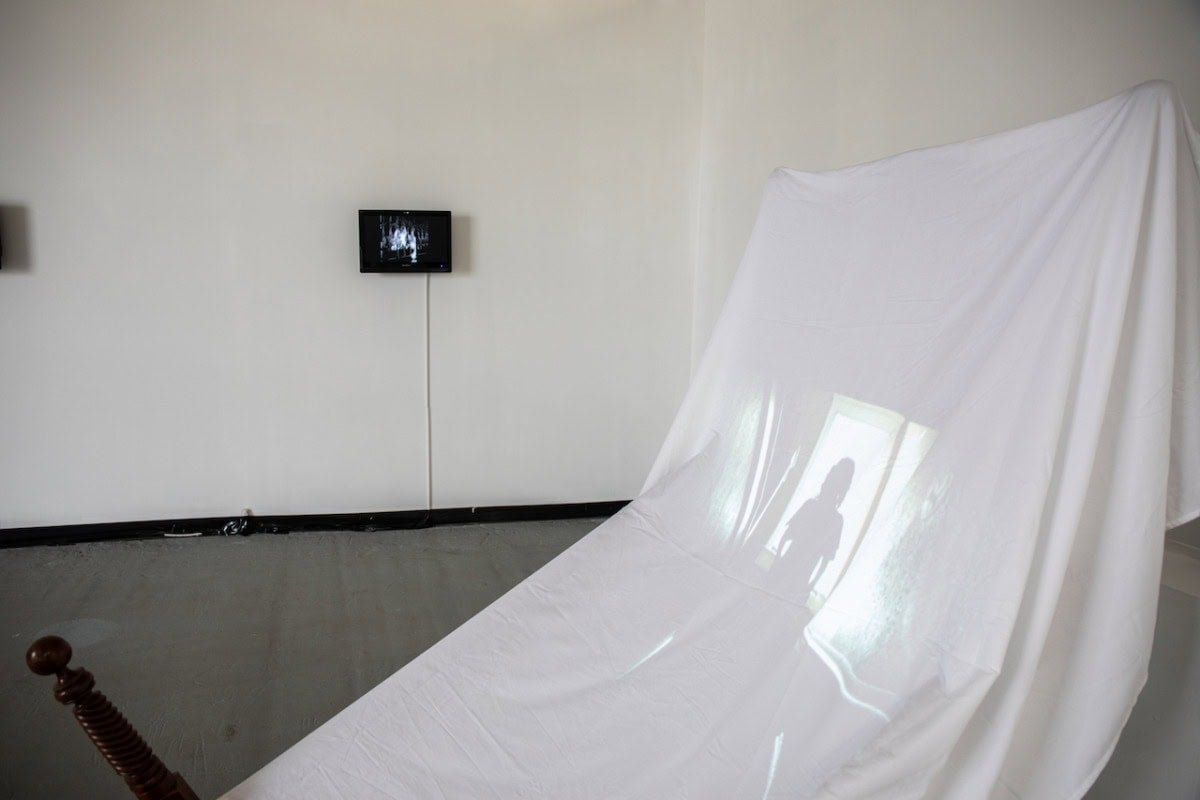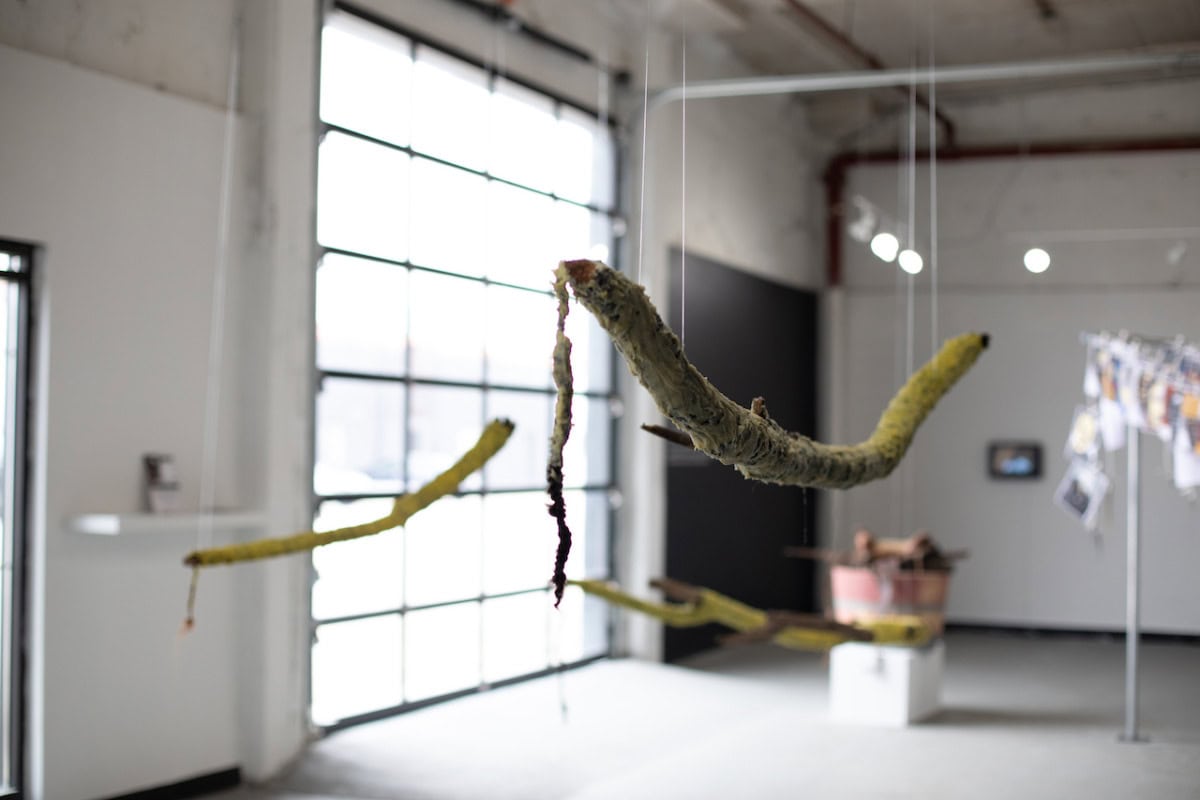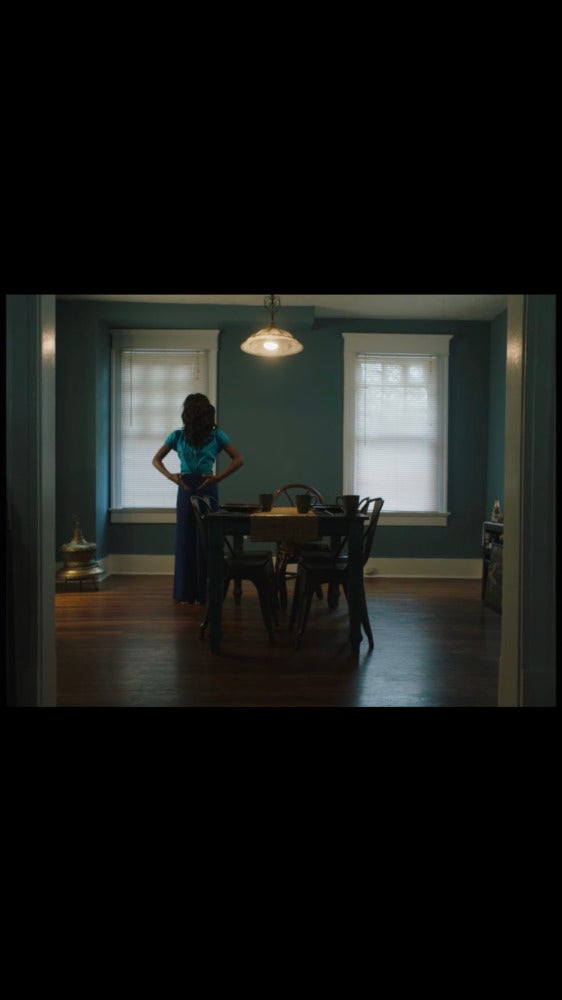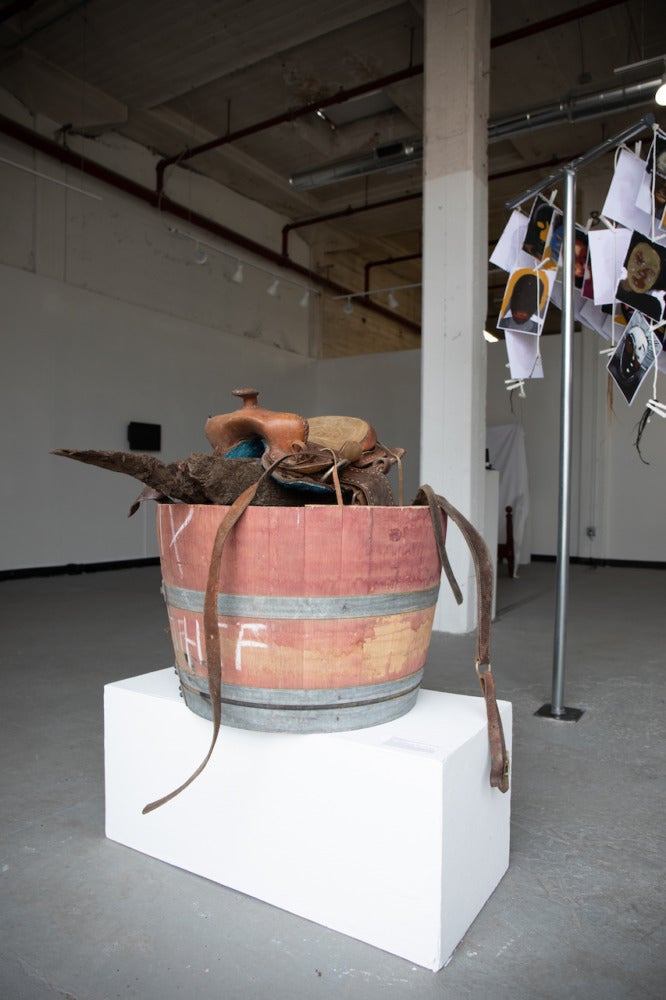Earlier this year, I asked Yves Jeffcoat to interview Atlanta artist, writer and actress Danielle Deadwyler about her current exhibition Will (to) Adorn at MINT, upcoming work in the Atlanta Biennial, and the power of rest and labor. This interview was conducted in person and has been edited for length and clarity.
Jasmine Amussen, editor

Yves Jeffcoat: What brought you to the idea of the Washerwomen Strike? What really stood out about that to you and the history of that and how it connected to the story that you wanted to tell and what you wanted to do with the exhibition, Will (to) Adorn?
Danielle Deadwyler: So I’ve been deeply invested in what it means to labor as a Black woman, as a Black mother. The pile up, the exhaustive nature of all of the things that one does. And this is just me cumulatively hoarding all of the things that I’ve done so far and sought to investigate. And my beautiful friend and peer and collaborator Angela Davis Johnson did a work, a collection of works at MINT in 2016 that connected to and had a through line story of the Washerwomen Strike of 1881 as well.
Over the course of a couple of years in developing the work , I kept going back. Why? Because it’s necessary to continue the legacy of telling the stories and the narratives that are not on the surface for Black folks to know.
The fact that the women of the Strike said, “We will not work anymore until we are given the value that we seek.” it felt overwhelming just to hear that. It’s a personal and a collective struggle that I think Black women have in defining how they seek to use their bodies and their minds.
I know I witnessed it in my mother. I witnessed it in my grandmother. I witnessed it in all of the women who have collectively developed me, whether they are biologically or culturally and spiritually connected. And to stop, to be restive in that act is to refuse to move and to cause something to skyrocket forward as well.
So let us walk with the knowledge of labor and of rest and not have to constantly cycle back to know that we are powerful in our stillness and we are powerful in our actions.

YS: Where were you in that moment that you said, “Oh, this is something that I need to return to.”
DD: I probably was in a space where I did not have a lot of jobs. I’m an actor, as well, that’s also the reason why I moved into doing performance art. To have a different kind of level of control with the work that I’m seeking to put out in the world. I probably had a little time to think a little bit more. I’ve been going through a major transformation just personally and spiritually over the last three, four years.
Also thinking about the Nap Bishop. The Nap Ministry. The power and impact of rest has been so important and critical to how I connect to ideas, how clarity comes. It’s like, “Wow, I actually had a dream. That’s fantastic.” And that dream spoke something else or connected dots that weren’t necessarily coming when I was in my waking state. So it was coming from that, that’s the place, yeah. The place of stillness.
YJ: I do feel like we’re also kind of in this moment where we’re so frequently saying, “Not doing is doing.” We’re frequently questioning the value of productivity and uplifting rest in a way that we never have before.
But at the same time, we’re also saying, “You can’t sit there and not do anything. You can’t be a keyboard warrior. You can’t only access things through social media.” You have to be out there, boots on the ground.
So I wonder, how you think about that space that we’re in with that duality happening and what refusal of doing means today in the context of your exhibition and what it’s saying.
DD: That’s such an exciting question. I don’t know. I don’t think I’ll ever stop thinking about labor, because I’ve been thinking about it since I was in high school. The science teacher said, “Your body is always at work, even when you’re sleeping.” What the fuck, it is? Okay. So I know that it lingered in my consciousness or my subconsciousness all this time. And when I got to being a mother, that’s when things got exhausting. It’s like, “Oh, are we, we’re really at work?”
We have to understand that we acutely work differently. It doesn’t work for our bodies under a white supremacist capitalist system.
To work is to convene with a spiritual dynamic. To work is to impart ourselves unto a collective. The chorus, if you are astute with Saidiya Hartman. The notion of individualism or American individualism and the singular is not defining us anymore. It never has. And the more our bodies engender that and the more we speak unto each other those truths and how we are feeling in this moment, the better and the more it shifts. That’s what’s happening right now.
It looks like that in the show. There’s this intergenerational shift between the youngest. Kendi is 20s. Angela is 30s. My mother is 60s. My grandmother is 80s. You’re feeling this workload is all yours. But it’s not, it never has been. There’s always a connective line. There’s always, with Octavia Butler, a primitive hypertext, this webbing of growth, of labor. And that’s how we should move forward. We did more in our forethought and less in the back and having to find it.
And rejecting that every day, when we recognize who is trudging along with us in the same way that the Washerwoman were 3,000 strong. You got 1,000-, 3,000-strong chorus with you too. And so I think that’s the difference, and refusal is not doing anything. It’s not doing anything anymore with that style, with this approach, with a supremacist understanding on our apron, if you want to play that game.
You know how people always go “Well, If I was living at that time…” I think about that kind of audience and trying to shift what their understanding is. I hope all kinds of people come to the show, but thinking about folks like that, you have to reassess how you perceive history. And that’s why the archive is a part of the work to say, “No, they weren’t stagnant, and they weren’t purely just accepting and falling into what our presumption or lack of knowledge of the time was.”

There’s a stillness to it, because it’s a photo, but at the same time the animation is seeking to say, a refusal to be stagnant at the same time. A kind of play on that restiveness is in that. And so I appreciate that. And I know all of these women, and I know these women have personally [experienced] and what they’re looking [at] … I’ve been watching their experience with themselves and with bringing babies into this world in rearing other human beings. I know that we need to recognize that connective tissue.
YJ: And can you talk a little bit about the repetition that shows up in the exhibition. I’m just thinking about the sound for the interstitials and some of the sound that’s layered in the background of bustitOpen and also thinking about the repetition and the layers that’s in lenticularities. Was that something that you were thinking about as you were creating, as you were going through your process? Or is that something that you happened to find?
DD: So repetition is a major part because that is thinking about endurance, at least in those early works, endurance is a substantial part of looking at the labor of Black women. The body and the mind being able to carry loads over and over and over again. But there is always a difference. I think this comes from Suzan-Lori Parks, the playwright: repetition, repetition difference, repetition, repetition difference.
There is a shift. There is a change through each generation. And yet even the mantra of 36 years being laid out in each one. That’s my grandmother, how long she worked at the chicken factory. My mom worked at her law firm—she’s still there—but she’s at 25 years. But she had umpteen years more of other labor somewhere else.
You’re carrying this ability to persevere, to carry that forth is a kind of trance-like state.
There are kind of different affirmations, be them spiritual or completely rugged and raw. Quotidian thoughts that are coming out, even with the use of text, to say “chill,” or to say “cool,” or to say “pussy,” or any of those things. At the same time, you are considering other aspects of life, even though you are doing this very rote kind of thing. It’s a constant conversation with the self, and a constant conversation going back and forth with the archive and with the surrealist imagination of what could be. Yeah, it’s just the imagination. What I want to possibly make happen, or what just lives here in this state of a fantasy or what comes when one is in their trance. It’s not just being servile.
YJ: I noticed that parentheses as well as brackets are something that often show up in the titling of your exhibition and also your works. Can you tell me a little bit about what meaning that has for you?
DD: Everybody is not at the same place at the same time. And I want to give myself the ability to choose and give others, or let others know you have the right to choose how this is… to take it or leave it. Some things are definitively there and some things are playing and toying with how to interpret it. And that interpretation is left up to you.
YJ: So, one phrase, while we’re on the subject of words and phrasing and semantics, one phrase that really stuck out to me, was in one of your pieces when you use the phrase, “life giving and taking,” in your description.

DD: Chinnamasta.
YJ: You said your grandmom was there for 36 years. What are your thoughts on the idea of the act or the essence of being life-giving and life-taking at the same time?
DD: I’ve been talking about this with my son a lot, he’s interested in these doom notions of like, “Oh, you know on January 20th, mommy, the world is going to implode.” I’m like, “Oh, word, it’s over? Cool. Well, actually, yeah, there might be a death, son. Is it a literal death? No, it’s something else.” That’s what I’m thinking about. I’m thinking about the choice to have a different perspective from day to day and thinking about my birth mother, on a literal level, handling chickens. The death of them and their ability to give life to others or the feeling that a rote-like state can feel deathly.
And then when you realize that you have the truest power to determine whether you’re going to—whatever your choice is—what you’re going to do with your body moving forward and how you can take the life of that thing that has become kind of mechanical or machine-like, that’s a part of what I’m accessing. Our ability to define ourselves. To choose to activate another aspect, another energy source. To bolt out the flame or to give it a more vibrant state.
I want people to be able to take it in for themselves. But Chinnamasta connects to the Hindu goddess who beheaded herself and then that blood that life force gave unto another couplet. So when you are the act, the actor of the death, what does that mean?
YJ: What kind of challenges were you faced with as you put this exhibition together, anything that you struggled with?
DD: I think patience is the biggest thing. It’s one of the larger teachers for me, because I think that’s my practice. I’m not necessarily always making a material thing in the way that others are. It’s processing thoughts. It’s also just allowing the narrative to come out because I’m an actor, because I come from theater and film and TV.
I need to understand art, and in order to understand art, you got to let the life of it happen first. And so that patience was the necessary part because the development of the lenticularities was over the course of a few years and the development of bustitOpen was over the course of the pandemic. I mean, that was the pivot. That was one of the challenges. How do I tell the story now?
You put the power in the people’s hands, because that was the intention anyway. Patience is really, really important. Because I feel like I’m in a state where I’m collecting things, collecting ideas, collecting experiences, so that therein it can come out in the way that it wants to.
YJ: I know that family is a big part of this, thinking about your own personal history. But also at the same time in parallel, thinking about the history of people who were also sharing this same space that you’re walking within today, as a person who lives in Atlanta and has been in Atlanta for a while.
DD: My family is not “from Atlanta,” from Atlanta. My family is from Athens and Social Circle. Me and my siblings, we were born here. I think about my parents being folks who said, “Oh, I want to move. Move economically, move literally, physically, move spiritually, connect to some other kind of energy.” But it’s not like they were in the Great Migration or nothing like that.
Which arguably they could have, because in thinking about The Warmth of Other Suns, they span it between the early 1900s and the ‘80s. My family decided to come to Atlanta in the ‘80s.
My mother has cleaned and worked as a maid in a certain capacity. And that’s a connective tissue to the Washerwomen. And those are the richer things that I connect to that history, to thinking about the history. And the Washerwomen were like, “We know you have control of our men, but you will not have control of us in that way. And do not forget this. We know this. We will have control.” I feel like my mom had a fluidity in the way that she got to choose to do all of these different things. I know my aunts have been very stable in the work that they’ve had, but my mom popped around a little bit more. And then chose to be still.
My mother quotes, she says jobs, literal jobs, since she was 16 years old. She doesn’t necessarily talk about her matriarchal care. She doesn’t talk about the stuff that she’s done incessantly to stay healthy or to stay fit. She doesn’t talk about dealing with the dynamics of having four kids. And that’s another marveled thing. You had four kids, and you did all of this shit? What the fuck.
I think it’s fantastic when—and that’s an understatement—how beautiful it is to claim your place. And white supremacy is a distraction. Toni Morrison has told us time and time again that it is. This is not new to us. It’s extremely visceral. It’s extremely spiritual. And it is a trance, you are being caught in a trance.
YJ: So, in terms of the 2021 Atlanta Biennial, can you just talk a little bit about your work for that, and your process, and creating for that? And just what it feels like to be a part of this shared space, or chorus, if I will, of Southeastern voices? And how you feel like that fits into this time in your life and the work that you’re creating. And also the specific time of a space that is in a way about connectivity, and space, and sharing, and what that feels like one year into pandemic.
DD: I don’t know what would’ve come of it had we not pandemic. It’s this weird thing of being completely distraught and traumatized as the collective is, the national collective, the Black American collective, and being, knowing that it’s present. And then all of these opportunities have sprouted. Just moving with that understanding. That’s what I’ve got on there.
And so I was truly pausing and taking these walks and thinking about how change happens and how growth happens. And what that’s looked like in Atlanta. And thinking about things that are left unseen, the invisible work. Because I was coming upon these anchors. My father labored with the railroad industry for 30 plus years. So then I’m pivoting to what does Black male labor look like?
I’m thinking about my dad. I’m thinking about how we see and don’t see the work of Black women. Like, the domestic part you’re not witnessing, but you love and adore her for it. And you don’t pay as much attention to what is happening publicly. And then I’m thinking about my dad and the value that is given his work because of how compensation, monetary compensation, happens for Black men and how it does not happen for Black women.
And thinking about how this city has developed, how it’s grown. And thinking about the hands that have worked and built this huge artery of connectivity for the city that therein went quiet, essentially, for years. And now it’s coming . . . it came and roared back and is revitalizing communities. And it’s this space for parks and for walking and for economic development and investment. And all of the people who were here before don’t get to benefit. All the people who lived in Techwood. All the people who lived in all the other homes.
We were the first city to roar with them, with the projects. And we are the first city to demolish all of them. And the city is defined by Black cultural aesthetics, Black cultural practice, Black cultural everything. If you come into Atlanta, you come in to be Black. You’re coming into Blackness. And then everything that’s shifting about the city through this major investment does not necessarily have ties to who has made it.
YJ: Do you think there’s anything particular about this exhibition that’s going to live with you?
DD: Yeah. It’s a pivotal part of my life in knowing how long I can carry something. How long I can gestate. Because I felt utter and complete. I mean, people go, “How do you feel? How do you feel?” I feel ease. Once you know your true practice, when you know how you need to step in the world, for lack of better terms, that brings a really true, beautiful state of ease. Yeah. And it don’t look like what you think it looked like. And it doesn’t have to look like what you witnessed. You’re here to make anew.
Danielle Deadwyler’s solo exhibition Will (to) Adorn is on view at MINT in Atlanta, Georgia through February 20, 2021.
Her work will be on view in Virtual Remains: The 2021 Atlanta Biennial at Atlanta Contemporary Art Center from February 20 through August 1, 2021.




